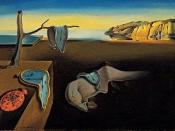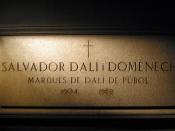Surrealist Assignment
Salvador Dali
"Spanish painter. Born into a middle-class family, he studied at the Academy of Fine Arts in Madrid, where he mastered academic techniques. Dalàalso pursued his personal interest in Cubism and Futurism and was expelled from the academy for indiscipline in 1923. He formed friendships with Lorca and Buñuel, read Freud with enthusiasm and held his first one-man show in Barcelona (1925), where he exhibited a number of seascapes. He wrote the screenplay for Buñuel's Un Chien Andalou (produced in 1928), largely thanks to which he was adopted by the Surrealists. In Paris he met Picasso and Breton, and his involvement from 1929 onwards, his effervescent activity, his flair for getting publicity through scandal and his vivacity which counterbalanced the political difficulties encountered by the group, made him a particularly welcome addition.
"Over the next few years DalÃÂ devoted himself with passionate intensity to developing his method, which he described as 'paranoiac-critical', a 'spontaneous method of irrational knowledge based on the critical and systematic objectivation of delirious associations and interpretations'.
It enabled him to demonstrate his personal obsessions and fantasies by uncovering and meticulously fashioning hidden forms within pre-existing ones, either randomly selected (postcards, beach scenes, photographic enlargements) or of an accepted artistic canon (canvases by Millet, for example). It was at this period that he was producing works like The Lugubrious Game (1929), The Persistence of Memory (1931) and Surrealist Objects, Gauges of Instantaneous Memory (1932). Flaccid shapes, anamorphoses and double-sided figures producing a trompe-l'oeil effect combine in these works to create an extraordinary universe where the erotic and the scatological jostle with a fascination for decay - a universe that is reflected in his other works of this period, including his symbolic objects and poems (La Femme visible, 1930; L'Amour et la mémoire, 1931)...



Disappointing
I'm not entirely sure of the level accepted from Grade 7 anymore, but Im certain that submitting an essay which is almost entirely derived from a website/book isn't acceptable.
http://www.artchive.com/artchive/D/d ali.html
Your entire essay was taken from that URL, except for the final paragraph which is a basic analysis of one of Dali's works.
2 out of 2 people found this comment useful.